‘Letter to my Breath’ at Fun Palaces, Bristol
Life of Breath collaborator Elspeth Penny writes about her experience facilitating a “Letter to my Breath” workshop at Barton Hill Settlement in Bristol as part of Fun Palaces 2018…
It’s like a present when I’m invited to run a workshop, am given a location and an afternoon. All I have to do is decide the best timings, turn up, and do the fun bit.
When Life of Breath asked me to run a workshop for Fun Palaces 2018 at Barton Hill Settlement, I was a happy person, as I’d been wanting to run a workshop for Fun Palaces for over a year, having attended a number of their inspirational meetings in 2017. Jordan Collver at Life of Breath, Ellie Shipman from the University of Bristol’s Elizabeth Blackwell Institute, and Barton Hill Settlement did all the hard work arranging, publicising and hosting the event.
My Letter to the Breath workshop involves hauling lots of boxes out of my car and into a room, setting up one large table or several tables, putting down a giant table cloth then emptying the boxes into different areas: paper over here, home-made inks and glitter, fabrics and essential oils over there. This is followed by having lots of fun, seeing what people have made, then packing it all up again.
Background
It was after I ran a workshop Letter to my Lungs, for a Breath Easy support group in the Forest of Dean that Dr Alice Malpass and I started to work closely together. A series of workshops followed, funded by Life of Breath, about which Alice and I have written over several years.
I mustn’t leave out mention of the primary driver in all of my work – the artistic side of things. Many moving personal stories emerge in the workshops and perhaps my favourite side of it all is knowing that people are sharing their stories, and often personal narratives they’ve not yet shared with anyone, or even known about themselves. As a writer and director, I can’t help but see potential for an expression of these stories in front of a live audience. Hence, Alice and I produced a series of artistic explorations in dance, installation, writing and music for Being Human Festival 2017, chaired by Life of Breath’s Professor Gene Feder. Our company, 2BU Productions, are applying for funding to extend that work into a theatre production, along with a public engagement schools programme, the latter which has already been part funded.
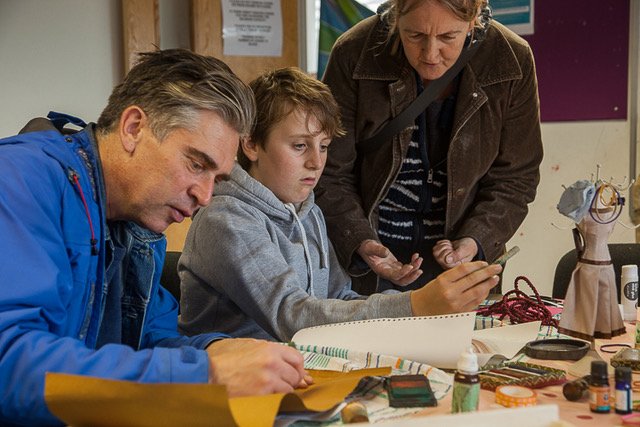
As is the nature of being part of an exciting cross-disciplinary study, there have been other outlets – presenting at The Storytelling Conference 2017 in Swansea and The Arts and Health South West Annual conference 2017. Alice and I have our first paper “Dear Breath: using story structure to understand the value of letter writing for those living with breathlessness – a qualitative study”, accepted for publication with Arts & Health journal and I’m looking forward to being on the panel for the Life of Breath final exhibition Catch Your Breath in Bristol in 2019 (currently on display in Palace Green Library, Durham).
It has occured to me recently that one way of looking at the work Alice and I have been doing is inviting people to create their own graphic medicine. To quote Bristol-based Paula Knight, writer of the stunning graphic novel ‘The Facts of Life’, who clarified graphic medicine for me:
“Graphic Medicine (GM), founded by Ian Williams and MK Czerwiec, is the intersection of comics, medicine and healthcare. A very important part of GM comprises personal illness narratives from the patient perspective. Some doctors use comics to relate their experience and comics are used to teach in medical education by some (mine have been used in teaching genetic counselling, for example.)”
The use of Paula’s comics in medical education illustrates a superb way in to a subject, taking primary consideration of the point of view of the patient. Graphic Medicine also provides informed stories for interested readers to witness, community for other people living with similar conditions, and to help friends, carers and family empathise and understand.
Of course, I already know how valuable it is to invite people to write their own letters – to create their own graphic medicine – in the shape of a letter to their own breath.
I recently have come across other graphic novels tackling health subjects recently. One of them through Tony Husband and Justine Schneider’s charming graphic novel ‘Winston’s World’ about carers which he wrote using the same University of Nottingham research which I used to write a play called ‘Silva Lining’s Care Plan’.

At a recent Bristol event – Laydeez Do Comics – which presents comic book artists or illustrators often exploring mental and physical illness including invisible illness, I watched presentations by Bristol illustrators Alice Urbino and Jade Perkin exploring grief, ME and many complex emotions, often hard to express in words.
The workshop and the letters
And so, back to our Barton Hill workshop. After first arriving, I delivered Life of Breath apparatus for a number of scientific and paint blowing activities into the biggest room we’d been given at Barton Hill and the team set to running those sessions. I didn’t have time to see much of these activities, but the letter writing side of things was very busy – I had two fantastic helpers, and we were kept on our toes for three hours.
I decided that it wouldn’t work to run the workshop as I usually do, as people were coming and going all afternoon, sometimes as whole families, sometimes alone, so I briefed the helpers to explain the activity and give a few prompts. We were inviting people to write or create a letter to their breath. The stress was on ‘creating’, because some people might not be comfortable writing, or be able to write.
If that was puzzling in any way, or if people needed a bit of extra help to get into the activity, then there are a number of questions that can be asked including – if you could hear your breath, what would it sound like? If you could see your breath, what would it look like? One girl said “Fire”. What does your breath smell like? – “The sea”.
In most cases this proved to be enough for people to start, by helping themselves to paper and then any number of materials to create their letter.
My guess is that at least 50 adults and children participated in some way. If any of the adults needed inspiration, all they needed to do was check out what the children were up to. The children were excitedly trying out lots of materials and in some cases making multiple letters, often very thoughtful ones too. About thirty people stayed for over ten minutes, some much longer. Our first participant made a stunning box and stayed for over half an hour and clearly wanted to stay, she’d enjoyed it so much.
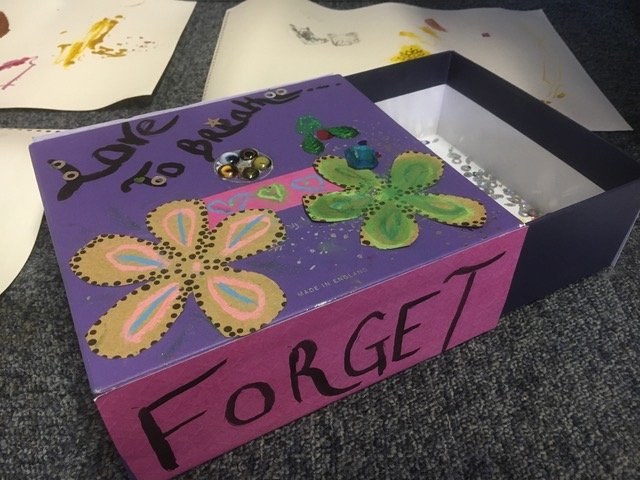

A girl decorated a box. She said she made it for her brother who has asthma and she put Turmeric inside. Her mother explained that they use turmeric at home because she has read it can help with asthma. She added that she didn’t think that doctors would understand the turmeric. The girl was really excited about giving the box to her brother, and told me, “I love this box’.
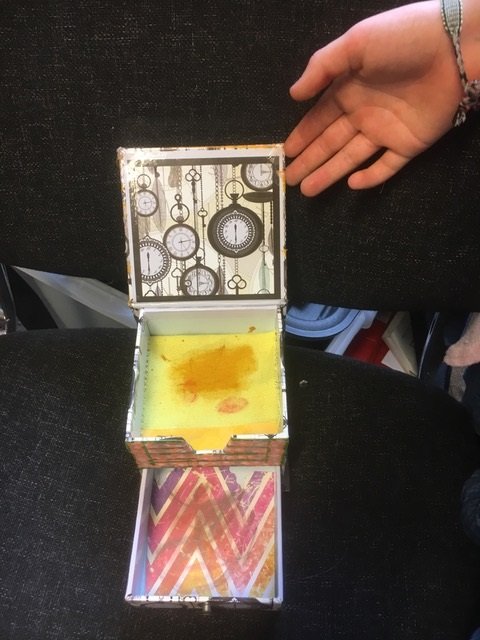
A woman with Chronic Obstetric Pulmonary Disorder (COPD), probably in her fifties, made a picture with sequins. She didn’t want to glue the sequins down because it might spoil it, and even liked the impermanence of unfixed sequins. In the end she did use glue, as she wanted to take it home. She made another picture with glued on lavender bundles (which she described as ‘bits of lungs’ and ‘green air’).
One participant made this green image below and left it for us to keep. Reading it from the right to the left, she said her breath is the dark circles and as she sees it, her breath goes through its journey to a different, more positive stage, on the left.
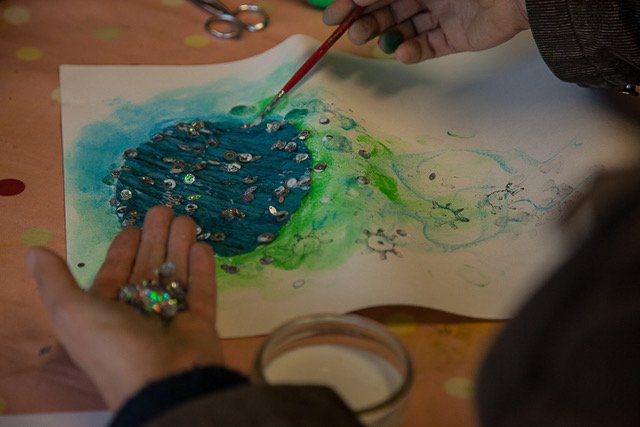
Another stunning colourful letter, which used a lot of different materials from tissue paper to paint and ink stamps, was by a girl about nine years old. She described her letter – ’This is my mouth and this is my breath, and this is what my breath is investigating, and these (green blobs) are my taste buds.’
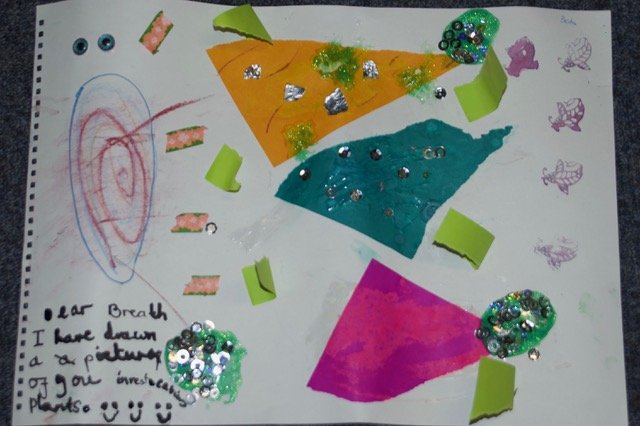
Nobody was counting how many letters were made, but I remember about 25. Most of the letters had no or very little writing on them, and most people took them home. There was a lot of free creativity in the room, and the room smelt amazing because of the essential oils. Lots of people told me how much they enjoyed the activity before they left, and planned to do more when they got home. It took some people a little while to get the idea of the activity, but given the right prompts, most people created some work that was meaningful to them.
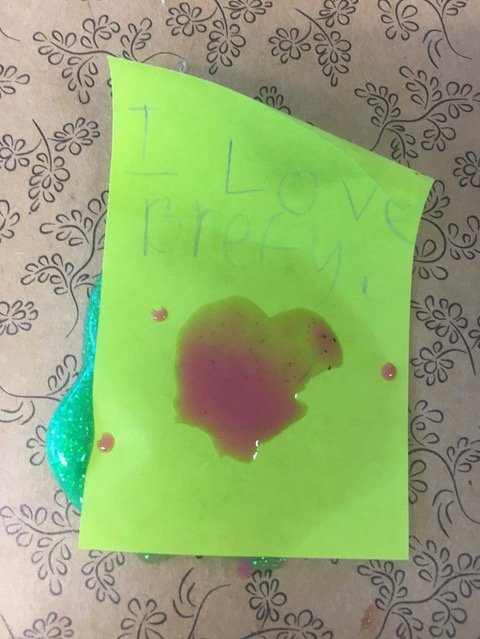

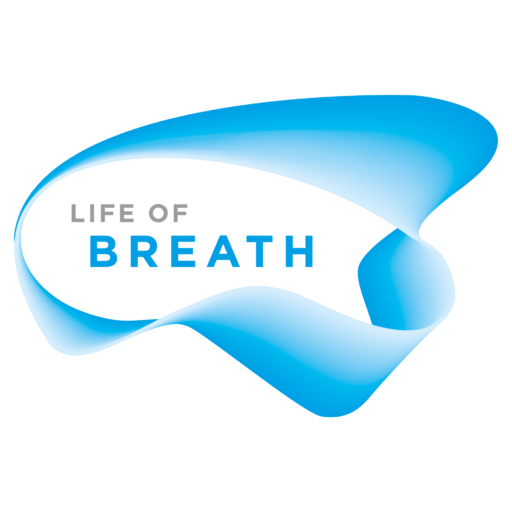


1 Comments
Malcolm Rigler